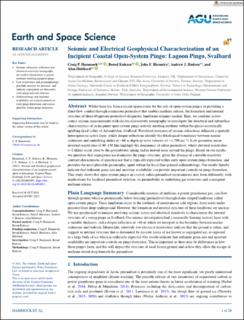| dc.contributor.author | Hammock, Craig Paul | |
| dc.contributor.author | Kulessa, Bernd | |
| dc.contributor.author | Hiemstra, John F. | |
| dc.contributor.author | Hodson, Andrew | |
| dc.contributor.author | Hubbard, Alun | |
| dc.coverage.spatial | Svalbard | en_US |
| dc.date.accessioned | 2022-03-17T12:51:10Z | |
| dc.date.available | 2022-03-17T12:51:10Z | |
| dc.date.created | 2022-01-05T13:03:23Z | |
| dc.date.issued | 2021 | |
| dc.identifier.citation | Hammock, C. P., Kulessa, B., Hiemstra, J. F., Hodson, A. J. & Hubbard, A. (2022). Seismic and electrical geophysical characterization of an incipient coastal open‐system pingo: Lagoon Pingo, Svalbard. Earth and Space Science, 9(3). | en_US |
| dc.identifier.issn | 2333-5084 | |
| dc.identifier.uri | https://hdl.handle.net/11250/2985863 | |
| dc.description.abstract | Whilst there has been a recent appreciation for the role of open-system pingos in providing a fluid-flow conduit through continuous permafrost that enables methane release, the formation and internal structure of these ubiquitous permafrost-diagnostic landforms remains unclear. Here, we combine active-source seismic measurements with electrical resistivity tomography (ERT) to investigate the structural and subsurface characteristics of an incipient open-system pingo actively emitting methane within the glacio-isostatically uplifting fjord valley of Adventdalen, Svalbard. Wavefront inversion of seismic refractions delineate a spatially heterogenoeus active layer, whilst deeper reflections identify the lithological boundaries between marine sediments and underlying shales at ∼68 m depth (p-wave velocity of ∼1790 ms-1). Low geometric mean inverted resistivities of 40 – 150 Ωm highlight the dominance of saline permafrost, whilst elevated resistivities (∼2 kΩm) occur close to the groundwater spring and in heaved areas around the pingo. Based on our results, we speculate that segregation ice dominates the pingo structure, given the absence of a notable resistivity contrast characteristic of injection ice that is typically expected within early open-system pingo formation, and provides the most plausible geomorphic agent within the local fine-grained sedimentology. Our results thereby indicate that sediment grain size and moisture availability can provide important controls on pingo formation. This study shows that open-system pingos in coastal, saline permafrost environments may form differently, with implications for localized permafrost structure, its permeability to underlying gas reservoirs and consequent methane release. | en_US |
| dc.language.iso | eng | en_US |
| dc.publisher | Wiley | en_US |
| dc.rights | Navngivelse 4.0 Internasjonal | * |
| dc.rights.uri | http://creativecommons.org/licenses/by/4.0/deed.no | * |
| dc.title | Seismic and electrical geophysical characterization of an incipient coastal open-system pingo: Lagoon Pingo, Svalbard | en_US |
| dc.type | Peer reviewed | en_US |
| dc.type | Journal article | en_US |
| dc.description.version | publishedVersion | en_US |
| dc.rights.holder | © 2021 The Authors | en_US |
| dc.source.pagenumber | 1-32 | en_US |
| dc.source.volume | 9 | en_US |
| dc.source.journal | Earth and Space Science | en_US |
| dc.identifier.doi | 10.1029/2021EA002093 | |
| dc.identifier.cristin | 1975133 | |
| dc.relation.project | Norges forskningsråd: 294764 | en_US |
| dc.relation.project | Norges forskningsråd: 223259 | en_US |
| cristin.ispublished | true | |
| cristin.fulltext | original | |
| cristin.qualitycode | 1 | |

